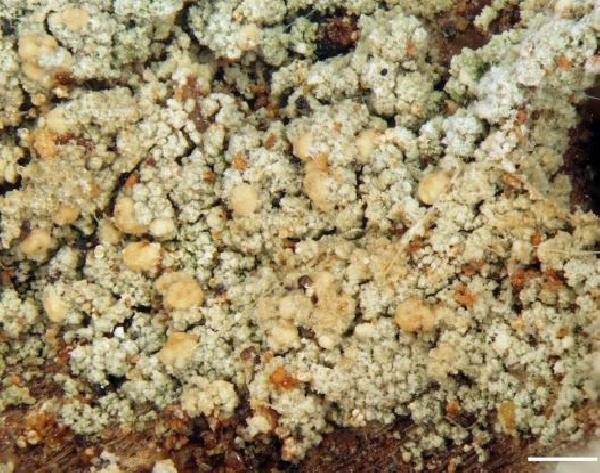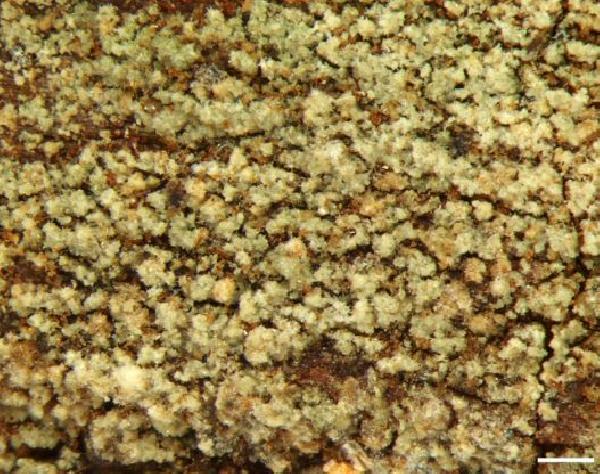Psilolechia torii Palice, S. Svoboda & Vondrák
Pl. Fungal Syst., 68, 2: 288, 2023.
Synonyms:
Distribution:
Description: Thallus crustose, episubstratic, green to grey-white, up to 0.2-0.3 mm thick, ecorticate and non-stratified, wide-spreading, continuously granular to granular-areolate or becoming farinose, the surface often more or less continuously covered by a white to greyish white hyphomycetous anamorph, more aggregated on convex granules/areoles and then resembling sporodochia. Apothecia 0.05-0.25 mm across, dispersed or locally abundant, sometimes aggregated or tuberculate and then to 0.4 mm across, whitish to pale ochre-yellow, more or less glossy, with a flat to slightly convex disc, emarginate. Proper exciple poorly developed and receding, indistinctly delimited, of c. 1.5 µm thick, radiating hyphae, sometimes with shortly protruding free ends; apothecial sections usually inspersed with c. 2 µm wide oily granules partly dissolving in K; hymenium colourless, 15-20(-25) µm high; paraphyses mostly branched, 1-1.2 µm thick, the apical cells hardly wider, or some paraphyses with 2-2.5 µm wide, capitate apical cells; hypothecium colourless, paraplectenchymatous but usually hardly discernable due to the inspersion of oily granules. Asci 8-spored, clavate, sometimes with a stalked narrow basal part, the apex poorly developed, an apical apparatus of the -type only rarely observed in young asci after K/I application, 12-18 x 4.5-5 µm. Ascospores 1-celled, hyaline, elongate-ellipsoid to tear-shaped, 4-6 x 1.5-1.8 µm. Conidiogenous hyphae superficial, erect, hyaline, the conidiogenous phialidic cells cylindrical, slightly widening at base, 10-18(-20) µm high and up to 2-2.5 µm wide at base. Conidia ellipsoid, pointed at one end, (2.5-)3-3.5(-4) x 1-1.2 µm, formed singly or in chains. Photobiont Stichococcus-like, of slightly elongated cells. Spot tests: thallus K-, C-, KC-, P-, UV+ ice-blue. Chemistry: 2-3 (or more) unidentified UV+ ice-blue substances. Note: this recently-described species has so far been recorded from a few localities in southern Bohemia, growing on rain-sheltered, decaying, soft coniferous wood of stumps in humid forests, where it inhabits rain-sheltered and quite shaded microniches. For further details see Palice & al. (2023). To be looked for in Italy, especially in the Alps.
Growth form: Crustose
Substrata: lignum
Photobiont: green algae other than Trentepohlia
Reproductive strategy: mainly sexual, or asexual by conidia and thalloconidia
In underhangs rarely wetted by rain

Predictive model

source: Palice Z, Svoboda S, Vondrák J. Hidden in the dark under umbrellas: two new Psilolechia species (lichenized Ascomycota, Lecanorales) described from the Czech Republic. Plant and Fungal Systematics. 2023;68(2):285-293. doi:10.35535/pfsyst-2023-0013. - CC BY 4.0
Psilolechia torii – overall habit of a richly fertile specimen.Paratype specimen (JM 13298). Scale = 0.5 mm.

source: Palice Z, Svoboda S, Vondrák J. Hidden in the dark under umbrellas: two new Psilolechia species (lichenized Ascomycota, Lecanorales) described from the Czech Republic. Plant and Fungal Systematics. 2023;68(2):285-293. doi:10.35535/pfsyst-2023-0013. - CC BY 4.0
Psilolechia torii – detail of tomentose thalli, whitish hairlike conidiogenous cells visible in part of thalli. Part of the holotype
specimen (ZP 29649). Scale = 0.2 mm.
Note: this recently-described species has so far been recorded from a few localities in southern Bohemia, growing on rain-sheltered, decaying, soft coniferous wood of stumps in humid forests, where it inhabits rain-sheltered and quite shaded microniches. For further details see Palice & al. (2023). To be looked for in Italy, especially in the Alps.
Growth form: Crustose
Substrata: lignum
Photobiont: green algae other than Trentepohlia
Reproductive strategy: mainly sexual, or asexual by conidia and thalloconidia
In underhangs rarely wetted by rain

Predictive model

source: Palice Z, Svoboda S, Vondrák J. Hidden in the dark under umbrellas: two new Psilolechia species (lichenized Ascomycota, Lecanorales) described from the Czech Republic. Plant and Fungal Systematics. 2023;68(2):285-293. doi:10.35535/pfsyst-2023-0013. - CC BY 4.0
Psilolechia torii – overall habit of a richly fertile specimen.Paratype specimen (JM 13298). Scale = 0.5 mm.


